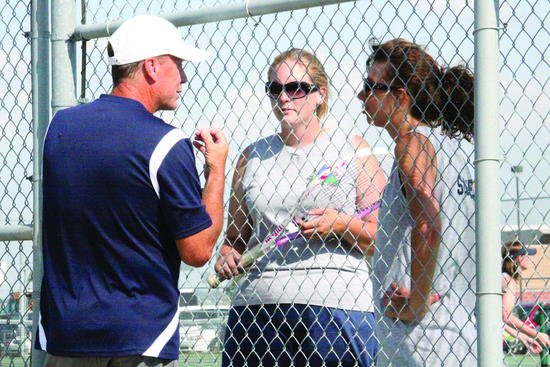On-court Coaching
 Saturday, July 28, 2012 at 03:09AM
Saturday, July 28, 2012 at 03:09AM  CAtennis
CAtennis  Coaching is defined by the USTA as [a] "communication, advice or instruction of any kind, audible or visible, to a player." A broad interpretation of this rule would make it impossible to hold competitons of any kind. Think, for example, of a scenario where the player double faults and the parent/coach lifts her eye-brows in shock. In theory, this is a visible communication by the parent to the player with the implied message being that the player should do a better job of getting her serves in.
Coaching is defined by the USTA as [a] "communication, advice or instruction of any kind, audible or visible, to a player." A broad interpretation of this rule would make it impossible to hold competitons of any kind. Think, for example, of a scenario where the player double faults and the parent/coach lifts her eye-brows in shock. In theory, this is a visible communication by the parent to the player with the implied message being that the player should do a better job of getting her serves in.
Therefore, the anti-coaching rule is a bit of a gray area and some communication between spectators and players is tolerated (e.g. "let's go", "nice playing", "stay tough", etc.). But with so much confusion between what's allowed and what is not allowed, how does one know when the line is crossed?
The simple answer is that the interpretation of the rule depends on the official(s) in charge. However, in our experience, we have found that while lengthy diatribes and complex discourses among players and coaches are frowned upon, some expressions of encouragement are acceptable. Although you are advised to proceed at your own risk, you may consider the following prompts during a match where the no-coaching rule applies:
1. "Good Start": this innocent expression can made to mean "take your time and focus on a good serve percentage" (this is especially useful when the player fails to realize that she's getting chopped up due to a drop in first serves). Again, you are not telling the player HOW to hit the serve or WHERE to do it.
2. "Push Yourself": again, another innocent expression that can be made to mean "move your feet" (this is particularly important where the player starts to rely on his arm as opposed to his legs to hit the ball).
3. "Keep Hunting": some players become fixated on implementing a limited strategy (e.g., hitting to opponent's backhand) and fail to see that there are other ways to win points. Keep hunting can remind them to keep looking for other opportunities. Again, you are not telling the player WHERE or HOW to hit the ball but this innocent expression reminds him to keep exploring and that you are OK with his experimenting.
4. Etc.
Before you criticize us for advocating for the breaking (or bending?) of any rules, please consider, for a moment, the fact that the rule itself is vaguely worded. As stated above, any verbal (e.g., "that's the way to play") or non-verbal gesture (e.g., clapping) can be infused with a subtle secret code (Morse Code clapping) between player and parent/coach. Thus, the key is to not stand out as much as the person next to you (sort of like filing tax returns).

Reader Comments